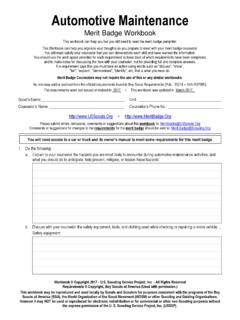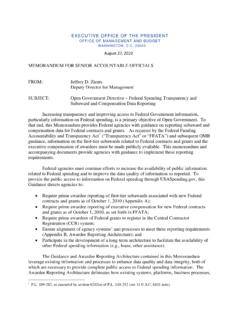Transcription of FINAL-NAMC-SWG Removal Technologies
1 Final Report Review of Available Technologies for the Removal of Selenium from Water Prepared for North American Metals Council June 2010. Tom Sandy, CH2M HILL. 11301 Carmel Commons Blvd. Suite 304. Charlotte, NC 28226. Cindy DiSante, CH2M HILL. 1100 112th Avenue NE, Suite 400. Bellevue, WA 98004. I. Acknowledgements The North American Metals Council Selenium Work Group and CH2M HILL would like to thank its members who contributed their experiences in management of selenium documented within this report. The Council and CH2M HILL also thanks the following sector leads for their time and contribution to this report: Alan Prouty (mining and agriculture), Keith Finley (power generation), and Sarah Armstrong (oil and gas). CH2M HILL also thanks Ron Jones, William Adams, and Peter Chapman for their guidance and contribution to this report.
2 The following CH2M HILL technologists contributed to this review: Harry Ohlendorf, Kar Munirathinam, Thomas Higgins, Jim Jordahl, Jim Bays, Dennis Fink, and Jamal Shamas. COPYRIGHT 2010 BY CH2M HILL, INC. III. Executive Summary This document describes industry-specific approaches to prevention, control and Removal of selenium in water, with a focus on water treatment approaches for selenium Removal . Industries represented in the North American Metals Council - Selenium Work Group (NAMC-SWG) are faced with managing selenium in water from processes that include the mining, agriculture, power generation, and oil and gas industry sectors. Case studies of pilot-scale and full-scale treatment Technologies for selenium Removal are presented for each industry sector. The development of low cost, reliable Technologies to remove selenium from water is a priority for the industry sectors as environmental standards and criteria applicable to their surface water discharges are currently very low with a potential for them to be even lower given pending guidance by regulatory agencies in North America.
3 Water treatment for the Removal of selenium will likely be a component of a successful selenium management strategy for industry to achieve selenium discharge requirements on the order of 1-5 g/L. Potential for selenium treatability should be considered in conjunction with water reuse, prevention and source control measures. Prevention of release and source control strategies for selenium may be more or less desirable or feasible depending upon the nature of the industrial process and associated costs compared to end of pipe water treatment. Generally, complete source control will not be possible or practical for process-affected waters from the various industry sectors. Source control approaches vary by industry sector. Agricultural strategies generally focus on improved irrigation practices and crop selection.
4 Selenium release reduction strategies for mining operations have generally focused around waste rock and tailings management. Power plants can minimize selenium release through design and selection of fly ash handling and flue gas desulfurization systems. For the oil and gas sector, selenium in produced water is a function of the production technology applied, and the resource deposit it is contained in, thereby posing significant challenges to applying source control approaches. Downstream refining source control strategies are generally limited to sour water management, crude washing and crude desalting operations. Achieving selenium levels on the order of 1-5 g/L in surface water discharges from the various industry processes poses a challenge given that selenium: Removal is limited by the minimum and maximum feasible ranges of design flows that can vary greatly over time.
5 Exists in a variety of chemical forms;. Is relatively dilute in concentration;. Removal from water is confounded by the water matrix ( , temperature, pH and other chemicals);. Treatment generally results in a concentrated by-product or residual; and, Re-release from the residuals can occur. COPYRIGHT 2010 BY CH2M HILL, INC. V. EXECUTIVE SUMMARY. Significant variation in selenium levels and forms exists among the different industry types, within each industry type, and even sometimes within the same facility over time. This increases the complexity of how to determine applicable selenium Removal Technologies to a wide variety of industries. Because of the various complexities associated with industry- specific waters, there is no treatment technology that is a one-size fits all solution.
6 Adequate characterization of wastewater or industrial process residuals that captures its seasonal variation and speciation should be performed to determine the applicable technology for Removal . Selection of the correct technology is highly dependent on the speciation of selenium and the competing and interfering water chemistry of industry- specific waters. The flows for some discharges vary greatly over the course of time and selection of the best technology will be limited by the minimum and maximum feasible ranges of design flows for a treatment system to function properly. A variety of physical, chemical and biological treatment Technologies have been shown to remove selenium from water. Applying these treatment Technologies must consider the aforementioned challenges.
7 This typically means that the treatment technology must be configured as a system that includes primary, tertiary and residual treatment processes in addition to the core treatment technology process. Because the performance of each technology is flow based, the system may require flow equalization infrastructure. The end result is a treatment plant that can have significant total installed and operations and maintenance costs. Costs presented in this document generally were either based on the literature referenced, or developed as part of completion of this document. Careful consideration of the costs and the basis of the estimates should be given in using any cost information. Many references will present costs for treatment systems without providing clear definitions of the basis for the cost estimate.
8 Most documents will only present the capital costs or direct costs for equipment as that is what is typically provided by the equipment supplier. These costs unfortunately are only a fraction of the total installed cost for a water treatment system. Total installed costs by definition include everything that will be required to install the system. This typically includes the following elements: Direct costs - equipment, delivery, taxes, and installation costs Indirect costs - engineering, construction, contingency for undefined items, escalation, permitting, startup and commissioning costs Total installed cost and operation and maintenance cost estimates and associated parametric cost graphs presented in this document are considered Class 5 cost estimates with an estimated accuracy of +100% and -50%.
9 Tertiary treatment will generally be required to meet both the selenium and other conventional surface water discharge guidelines or criteria ( , dissolved oxygen, total suspended solids, biochemical oxygen demand, etc.). Residuals or by-product treatment will be required for most systems. The residuals will contain concentrated levels of selenium that, if disposed of as a solid or liquid waste, will need to comply with other disposal regulations ( , USEPA RCRA Hazardous Waste). By-products may require further treatment to ultimately reduce the selenium to a less hazardous form. VI COPYRIGHT 2010 BY CH2M HILL, INC. EXECUTIVE SUMMARY. Table ES-1 is a summary table of the treatment Technologies (arranged alphabetically). discussed in this review. It includes technology description, Removal treatment, key design considerations such as flow or concentration limitations or the extent and significance of any confounding factors, main advantages and disadvantages, and capital and operating costs.
10 While these physical, chemical and biological treatment Technologies have the potential to remove selenium, there are very few Technologies that have successfully and/or consistently removed selenium in water to less than 5 g/L at any scale. There are still fewer Technologies that have been demonstrated at full-scale to remove selenium to less than 5 g/L, or have been in full-scale operation for sufficient time to determine the long-term feasibility of the selenium Removal technology. No single technology has been demonstrated at full-scale to cost-effectively remove selenium to less than 5 g/L for waters associated with all industry sectors. Therefore, performance of the technology must be demonstrated on a case-specific basis. Information exchange among and within industries is necessary to advance Technologies for selenium Removal .






